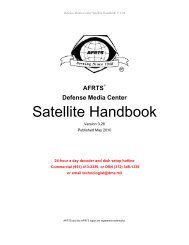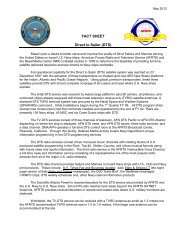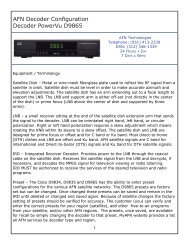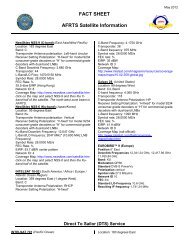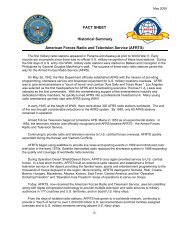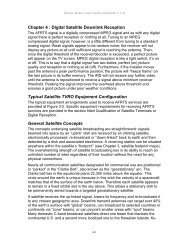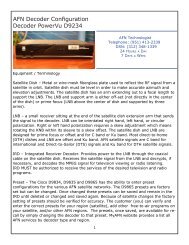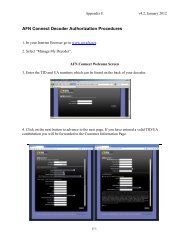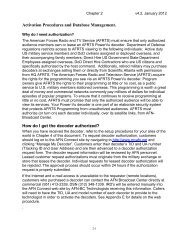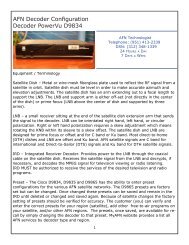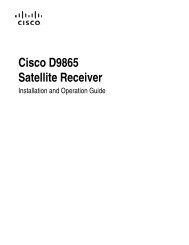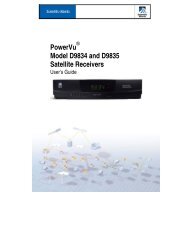AFRTS Defense Media Center Satellite Handbook
AFRTS Defense Media Center Satellite Handbook
AFRTS Defense Media Center Satellite Handbook
You also want an ePaper? Increase the reach of your titles
YUMPU automatically turns print PDFs into web optimized ePapers that Google loves.
<strong>Defense</strong> <strong>Media</strong> <strong>Center</strong> <strong>Satellite</strong> <strong>Handbook</strong> V.3.26<br />
The LNA is a weather sealed unit that provides enough gain to transport the<br />
signal from the antenna to the receiver. It is located as close the feedhorn as<br />
possible to minimize signal loss and thereby improving signal to noise ratio. The<br />
problem with an LNA is that the signal is in several gigahertz frequency range<br />
and requires expensive transmission lines to carry the signal from the antenna to<br />
the receiver. A much more efficient way of doing this is to down-convert the<br />
signal at the antenna to a lower frequency for transmission to the receiver. This is<br />
accomplished with the newer LNB/C/F to lower the satellite normal GHz<br />
frequencies to an L-band frequency between 940 MHz to 1450 MHz. For ease of<br />
discussion, all Low Noise Amplifier types will be referred to as a LNB, form this<br />
point forward<br />
There is a basic tradeoff between LNB noise temperature and antenna size,<br />
which is gain, expressed by the system figure of merit G/T. Smaller antennas<br />
require a cooler LNB temperature for equivalent system performance. Whereas a<br />
larger antenna allows use of an LNB with a higher noise temperature. This<br />
should not be misunderstood and you should not be mislead that an amplifier<br />
with a lower noise temperature will correct for any antenna size. G/T is a<br />
measure of the ability of a receiving system to amplify very weak signals, such as<br />
those of a satellite transmitter 22,300 miles away over the background noise. The<br />
“G” is antenna gain and the “T” is its noise temperature. The job for the LNB is to<br />
overcome this noise figure with a carrier to noise C/N separation of greater than<br />
8dB, see Spectrum Analyzer plots. The average for reliable reception of the<br />
<strong>AFRTS</strong> digital signal is 12dB of signal above the noise floor. It should be noted<br />
also that a digital signal reacts to noise and interference differently than a analog<br />
signal. Noise or interference introduced in a digital environment will cause<br />
pixelization and even loss of signal reception. Whereas in the analog world,<br />
received video will have noise or sparkles but in most instances would not suffer<br />
total loss of signal. The advantage of the digital signal is, there is no change in<br />
the signal quality until it deteriorates below the receiver reception threshold. But,<br />
at that point the received video will go from perfect to total loss of signal; notice<br />
there is no in between.<br />
The noise figure or temperature, expressed in decibels or degrees Kelvin,<br />
respectively, is a measure of the degree by which this amplifier degrades or<br />
decreases the signal-to-noise ratio of the satellite signal as it passes through the<br />
device. This scale is based on the fact that at a temperature known as absolute<br />
zero, 0° K (equal to minus 273.16° C or minus 459.72° F), molecular motion<br />
ceases and consequently all electronic noise disappears. The lower the noise<br />
temperature or figure, the better amplifier performance. There are amplifiers on<br />
the market today with noise temperatures as low as 15°. Getting below 15° K,<br />
requires external cooling of the electronics and is a very expensive endeavor.<br />
Gain is also very important in characterizing low noise amplifiers. The more<br />
common LNB gains today usually range from 60 to 70 dB. LNBs must be<br />
designed with sufficient gain to overcome cable losses as well as the effects of<br />
noise contributed within this device and overall system noise temperature.<br />
4-5



